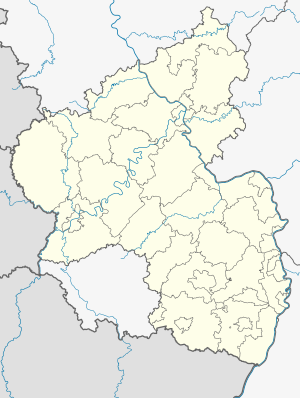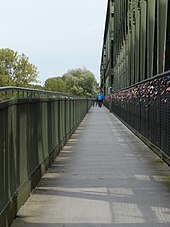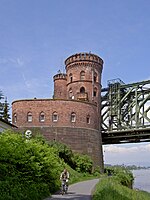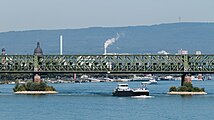South Bridge (Mainz)
Coordinates: 49 ° 59 ′ 29 ″ N , 8 ° 17 ′ 38 ″ E
| South Bridge (Mainz) | ||
|---|---|---|
| in the evening light with the mouth of the Main in the foreground | ||
| Convicted | Rhein-Main-Bahn , Mainbahn | |
| Subjugated | Rhine | |
| place |
Mainz old town - Ginsheim-Gustavsburg |
|
| construction | Pauli carrier / semi-parabolic carrier / K carrier | |
| overall length | 1028 m | |
| Longest span | 2 × 106.6 m | |
| Headroom | 9.1 m at HSW | |
| start of building | 1860 (1868), 1910, 1948 | |
| opening | 1862 (1871), 1912, 1949 | |
| planner | Heinrich Gottfried Gerber | |
| location | ||
|
|
||
The Mainzer Südbrücke (also: Eisenbahnbrücke Mainz-Süd , sometimes also: Mainz-Gustavsburg Railway Bridge ) is a railway bridge that connects Mainz in Rhineland-Palatinate across the Rhine with Ginsheim-Gustavsburg in Hesse .
Surname
The bridge never received an official name and is therefore still referred to in different ways to this day.
location
The bridge stands south of the old town of Mainz directly above the confluence of the Main and the Rhine at Rhine-kilometer 496 between the Mainz Roman Theater train station in Rhineland-Palatinate and the Mainz-Gustavsburg train station in Hesse . It begins on the left bank between the two preserved neo-Gothic bridge towers. On the right bank, the proportions of the bridge piers on the shore show that the eastern bridge towers that stood on them until the Second World War were much more modest. From there, foreshore bridges, almost as long as the bridge over the river, extend through the dike foreland on the Mainspitze to just before the Mainz-Gustavsburg train station in the city of Ginsheim-Gustavsburg .
Function and meaning
The south bridge serves the Rhein-Main-Bahn from Mainz via Darmstadt to Aschaffenburg and the Mainbahn from Mainz to Frankfurt (Main) Hbf , which runs south of the Main and on which the S 8 line also runs between Mainz, Frankfurt (Main) Airport and Frankfurt.
Pedestrians and cyclists can also cross the Rhine on a footbridge attached to the outside of the bridge structure.
After the Römerbrücke and Charlemagne's Rhine Bridge, which burned down shortly after its completion, the Mainz Südbrücke from 1862 was the first permanent Rhine bridge in Mainz that until then had only had a ship bridge . At the same time it was the fourth railway bridge over the Rhine after the Rhine bridge Waldshut – Koblenz on the Upper Rhine , the Rhine bridge Kehl and the Hohenzollern bridge in Cologne .
history
Pauliträgerbrücke (1862)
The lines of the Hessian Ludwigsbahn built between 1853 and 1859 on the left and right of the Rhine were initially only connected by the Mainz – Gustavsburg trajectory , where two paddle steamers dragged pontoons with freight wagons across the Rhine and used rail travelers as a ferry.
In the years 1859 to 1862 the south bridge was built according to the plans of the head of the bridge construction department of the iron foundry Klett & Comp. from Nuremberg , Heinrich Gottfried Gerber , built. For construction work, Gerber had a building yard with a workshop set up in Gustavsburg, where the wrought-iron girders were assembled. He and his family moved into a house in Gustavsburg near the construction site in order to better coordinate and monitor the work. From the depot later a developed branch of Maschinenfabrik Klett and finally the "Gustavsburg" the MAN .
The bridge had four bridge fields , each 105.2 m long, with Pauli girders above the roadway , as the lens girders developed by Friedrich August von Pauli were called. A long flood bridge with 28 additional fields followed on the right bank of the Rhine. Neo-Gothic portals with bridge towers were built at both bridgeheads. After the destruction in the Second World War , only the system on the Mainz side has been partially preserved. The bridge towers had a purely decorative function, were intended to visually shield the technical construction of the bridge, which was unfamiliar to the observer at the time, and had no military function. The architect of the towers is probably Justus Kramer, who was then responsible for the high-rise buildings of the Hessian Ludwig Railway . They were also attributed to Ignaz Opfermann . However, after the completion of the Mainz – Worms line in 1853, he no longer worked for the Ludwigsbahn.
The south bridge was designed for double-track traffic from the start, but initially only received a single-track superstructure . The carriers were assembled in just nine months, so that the first test drives could take place on December 4, 1862. The south bridge was put into operation on December 20, 1862. At 1:15 a.m., the inaugural train from Frankfurt reached the bridge, crossed it and arrived five minutes later at the old Mainz Central Station . Shortly afterwards, he drove on to the electoral palace (the route then ran along the banks of the Rhine), where the 14-course banquet took place. The bridge has been operated according to schedule since January 3, 1863 .
Between 1868 and 1871, the bridge for the second, northern track was laid parallel to the existing superstructure, for which Gerber moved back to Gustavsburg. He was particularly careful to manufacture many prefabricated parts in the yard so that as little riveting as possible had to be carried out on the bridge construction site.
Because of the increased traffic loads, the southern river bridges were reinforced in 1901 and the tracks of the 28 approach bridges were replaced.
Semi-parabolic girder bridge (1912)
Ten years later the traffic loads had increased further. In addition, the clearance profile of the bridge no longer corresponded to the standard dimensions that were now valid and was a few millimeters too tight. In 1911 all the superstructures were renewed: steel semi-parabolic girders with spans of 104.96 m were installed over the four main openings , the approach bridges received truss and sheet metal girders for two shorter approach bridges. The bridge portals between the bridge towers were demolished in October 1910. Construction work began on May 6, 1910, and was completed on July 1, 1912. The northern track was put into operation on July 12, 1911, and double-track operation began on July 4, 1912.
War damage
The south bridge has been in the last days of World War II, on 17 March 1945 by pioneers of the armed forces blasted to the advancing American troops unstoppable. American pioneers then erected a single-track , partly wooden temporary bridge above the destroyed bridge , which was built in record time and put into operation on April 14, 1945. It was named Franklin D. Roosvelt Memorial Bridge , but had no passage for shipping. Therefore it was replaced by a second temporary bridge on January 18, 1946. This was named after General George C. Marshall .
K truss bridge (1949)
From 1948 to 1949, the south bridge was rebuilt with two parallel-chorded K-steel trusses . Only the western bridge towers to the Mainz city park have been preserved. This bridge leads over four stream fields with spans of 106.6 - 105.6 - 105.6 - 106.6 m. It is an auxiliary bridge of the type SKR 6 ( S chaper ; K rupp; R eichsbahn; 6 meters field width) with the two-story construction as a permanent bridge. The trusses have a K truss that is twelve meters high. The widths of the foreland bridge directly to the east are 6 × 35 - 13 × 15.8 - 2 × 26 - 7 × 15.8 m.
Renovation (2008-2010)
After 60 years, the bridge was in urgent need of renovation. The necessary work began in 2008. The adjoining foreland bridge on the right bank of the Rhine was also renovated between 2008 and 2010. To this end, a single-track operation was initially set up, in order to repair one side and then the other. In order to be able to carry out the construction work as effectively as possible, changes were made to the timetable, with which some of the trains were diverted to the Mainz bypass .
In addition, the combined cycle and footpath was much too narrow for today's conditions and was widened in the course of the renovation; for this purpose, the path for the widening was completely closed from mid-April 2009 to April 2010. The neighboring municipalities bear these costs for the expansion. The German Bahn AG had wanted to eliminate the cycling and walking in the renovation.
On the Hessian side, the bridge is a cultural monument according to the Hessian Monument Protection Act , on the Rhineland-Palatinate side the bridge towers are cultural monuments due to the Monument Protection Act of the State of Rhineland-Palatinate .
Picture gallery
literature
in alphabetical order by authors / editors
- Michael Bermeitinger: Anniversary: Südbrücke or Mainz Railway Bridge - 150 years and still no name ( memento from January 1, 2013 in the Internet Archive ). Allgemeine Zeitung , December 29, 2012.
- Hans-Wolfgang Scharf: Railway Rhine bridges in Germany . Freiburg 2003, pp. 130-143. ISBN 3-88255-689-7
- Peter Scheffler: The railway in the Mainz - Wiesbaden area . Eisenbahn-Kurier Verlag, Freiburg 1988. ISBN 3-88255-620-X , pp. 193-199.
- Heinz Schomann : Monument topography Federal Republic of Germany . Cultural monuments in Hessen. Railway in Hesse. Volume 2.1: Railway structures and lines . Ed .: State Office for Monument Preservation Hesse . Theiss Verlag, Stuttgart 2005, ISBN 3-8062-1917-6
- Angela Schumacher, Ewald Wegner: Monument topography Federal Republic of Germany . Monuments in Rhineland-Palatinate 2.1 = City of Mainz. City extensions in the 19th and early 20th centuries : 2nd edition. Wernersche Verlagsgesellschaft, Worms 1997. ISBN 978-3-88462-138-7
- Heinrich Tecklenburg: Reconstruction of the railway bridge over the Rhine above Mainz. In: Newspaper of the Association of German Railway Administrations, Volume 52, No. 70 (September 11, 1912), pp. 1113–1115.
Web links
- Location of the bridge on the OpenRailwayMap
- Bridge friend
Individual evidence
- ↑ The Rhine ( Memento of the original from February 9, 2015 in the Internet Archive ) Info: The archive link was inserted automatically and has not yet been checked. Please check the original and archive link according to the instructions and then remove this notice. on Rheindex
- ↑ a b c d e f Hans Pottgießer: Railway bridges from two centuries . Birkhäuser Verlag, Basel Boston Stuttgart 1985, ISBN 3-7643-1677-2 , pp. 146-148.
- ↑ Schumacher, p. 202
- ↑ Silvia Speckert: Ignaz Opfermann (1799–1866): Selected examples of his construction activity in the vicinity of the city of Mainz = housework to obtain the academic degree of a Magister [!] Artium. Johannes Gutenberg University Mainz 1989. Typed. Volume 1: Text, Volume 2: Tables. Mainz City Archives: 1991/25 No. 11, p. 71, note 306.
- ^ Otto Westermann: Young Railway in 2000-year-old golden Mainz. From the good and bad days of the Mainz Railway . Federal Railway Directorate Mainz, Mainz undated [after 1962], p. 32.
- ^ Fritz Paetz: Data collection on the history of the railways on the Main, Rhine and Neckar . Bensheim-Auerbach 1985, p. 9.
- ↑ Eisenbahndirektion Mainz (ed.): Official Gazette of the Royal Prussian and Grand Ducal Hessian Railway Directorate in Mainz of August 24, 1907, No. 43. Announcement No. 464, p. 468; The Railway Directorate repeatedly pointed out this deficiency, at least every time the timetable was changed. E.g. Eisenbahndirektion Mainz (ed.): Official Gazette of the Royal Prussian and Grand Ducal Hessian Railway Directorate in Mainz from May 15, 1909, No. 24. Announcement No. 352, p. 244; ibid. Announcement No. 733, p. 468.
- ↑ Eisenbahndirektion Mainz (ed.): Official Gazette of the Royal Prussian and Grand Ducal Hessian Railway Directorate in Mainz from September 9, 1911, No. 45. Announcement No. 577, p. 333.
- ^ Michael Heinzel: Return and advance . In: EisenbahnGeschichte 75 (2016), p. 75; According to another source as early as December 19, 1945 (see: General George C. Marshall Railway Bridge ( Memento of February 4, 2015 in the Internet Archive ); accessed on February 15, 2015).
- ^ Rolf H. Pfeifer, Tristan M. Mölter: Handbuch Eisenbahnbrücken . DVV Media Group, Hamburg 2008, ISBN 978-3-7771-0378-5 , p. 302.
- ^ "Bridge closed longer" , AZ of November 30, 2009
- ^ "Bridge open again" , AZ of April 23, 2010
- ↑ "The General German Bicycle Club (ADFC) calls for a wider cycle and pedestrian path on the southern railway bridge", Mainzer Allgemeine Zeitung of October 18, 2006
- ↑ "Support plates above the Mainspitze will be renovated from 2008 - the city wants to use this to widen the cycle path", Mainzer Rhein-Zeitung of August 5, 2006
- ↑ Schomann, pp. 234-235.
- ↑ Schumacher, p. 200ff.
|
The next bridge upstream: Weisenauer Bridge |
Bridges over the Rhine |
The next bridge downstream: Schiffsbrücke (Mainz) (historical) Theodor-Heuss-Brücke (Mainz – Wiesbaden) |
















